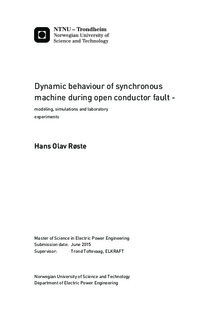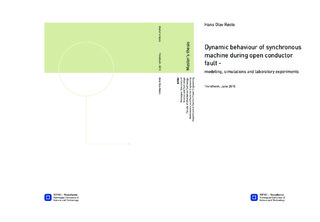| dc.description.abstract | The topic of this master thesis deal with stability issues in the hydro power plant Nedre Fiskumfoss Kraftverk (NFK) where speed and power oscillations occurred in the synchronous generators after an open conductor fault the 7th of March 2008. It was observed that G1NFISKUM generator output varied from 0 to 100 % within 2 seconds during the uncontrolled oscillations.
The scope of work consists of literature review, computer simulations and laboratory experiments in order to study dynamics of open conductor faults. The power plant and power system is studied by dynamic analysis with by means of linear analysis and laboratory experiments with aim to find the main factors that influence the uncontrolled power oscillations in NFK.
The linear analysis and eigenvalue calculations indicates that the network is small signal stable. However, the dynamic simulation of the Base Case network show that the network model experience underdamped oscillations, with an oscillation period of 1,2 seconds, like the open conductor fault that occurred the 7th of March 2008.
The dynamic simulation results and linear analysis show that the settings on the AVR and turbine governor have negative impact on system stability. Modifications on the parameter settings on the regulators improved transient response.
Simulations of symmetrical three-phase short circuit and open conductor fault is conducted to compare the damping properties. The results show that the damping ratio is 0,77 % and 0,78 % for symmetrical three-phase short circuit and open conductor fault, respectively, when the actual regulators are implemented. The results with modified regulators show damping ratio 2 % and 0,91 % for the same fault cases, which is an improvement and a significant difference in damping ratio during different fault cases.
The exact reason why simulation results show different transient response for symmetrical three-phase fault and open conductor fault with modified regulator settings are not found. It is speculated that unfavourable load flow conditions and fault location influence the transient response of the generators in NFK, but this is not verified through simulations. The modified parameter settings may give an incorrect response of the generators dynamic behaviour.
Laboratory experiments have been conducted to study the open conductor phenomena and to re-enact the open conductor fault event that happened the 7th March 2008. Although the laboratory test setup did not reproduce the properties of the real world network, the results provide basis for further stability studies regarding open conductor faults and oscillation problems.
Based on the simulations and laboratory experiments, the results indicates that the AVR and turbine governor in the generators in NFK were unable to provide sufficient damping torque, in combination with unfavourable load flow conditions at the time of the fault event, which led the power plant to experience severe oscillations during the open conductor fault, and eventually system collapse. | |

